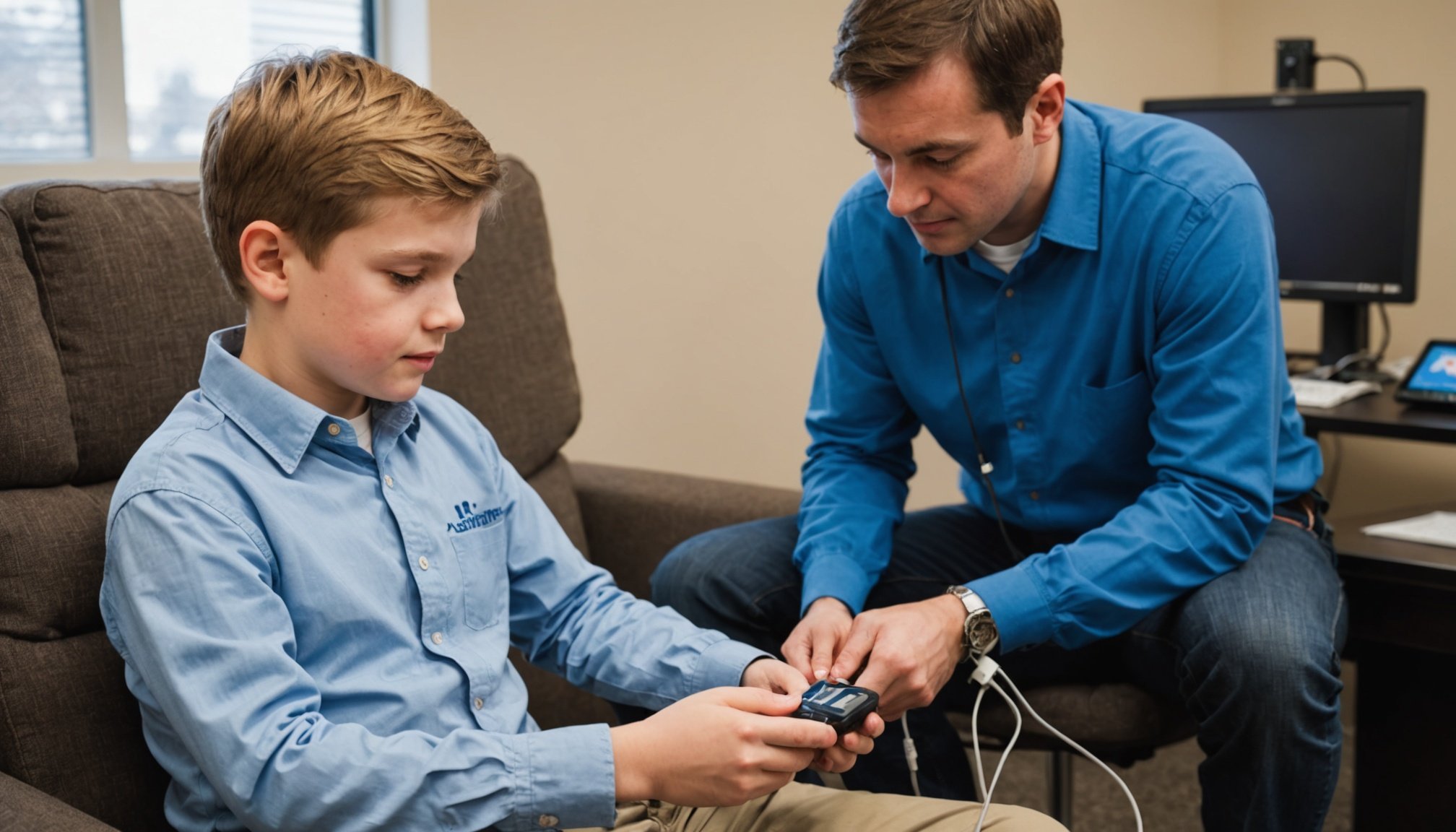Unlocking the Advantages of Deep Pressure Stimulation for People with Autism: A Comprehensive Guide
Deep pressure stimulation, often referred to as deep pressure therapy (DPT), has emerged as a highly effective and comforting technique for individuals with autism spectrum disorder (ASD). This therapy involves applying gentle, consistent pressure to the body, which can have a profound impact on reducing anxiety, enhancing focus, and promoting better sleep. In this guide, we will delve into the benefits, methods, and practical applications of deep pressure stimulation, providing you with a thorough understanding of how this therapy can support individuals with autism.
Understanding Deep Pressure Therapy
Deep pressure therapy is a form of sensory integration therapy that has been widely adopted by occupational therapists and caregivers to support children and adults with ASD. The principle behind DPT is simple yet powerful: by applying firm, gentle pressure to the body, it can calm the nervous system and reduce anxiety.
Topic to read : Unlocking the Potential of Telemedicine for Effective Management of Chronic Skin Disorders
“As deep pressure therapy works by applying gentle, consistent pressure to the body, it creates a calming sensation similar to a hug or a firm touch,” explains Emily, a seasoned blog writer for Goally, who specializes in child psychology and special education. “This pressure helps regulate the nervous system, leading to a more relaxed and composed state of mind”.
Benefits of Deep Pressure Therapy
The advantages of deep pressure therapy are multifaceted and can significantly improve the quality of life for individuals with autism.
Also read : Unlocking Healing: The Impact of Narrative Therapy on Veterans Battling PTSD
Reducing Anxiety and Meltdowns
One of the most significant benefits of DPT is its ability to alleviate anxiety and meltdowns. By providing a calming sensory input, DPT can lower cortisol levels, the hormone responsible for stress. This can result in fewer meltdowns and a more relaxed state throughout the day.
- Weighted Blankets: These are designed to provide deep pressure input while sleeping, mimicking the sensation of a gentle hug.
- Compression Vests: These vests apply consistent pressure to the torso, helping to reduce anxiety during daily activities.
- Body Socks: These are full-body garments that provide deep pressure input, often used during occupational therapy sessions.
- Deep Pressure Massages: Manual therapy where a trained therapist applies deep pressure to specific areas of the body.
Boosting Focus and Attention
DPT is also highly effective in enhancing focus and attention. By providing soothing sensory input, it helps filter out distractions, allowing individuals to concentrate on tasks more effectively.
“For instance, using a weighted lap pad during schoolwork or a compression vest during playtime can help your child stay engaged and attentive,” notes Emily. “This can be a game-changer for kids with sensory processing difficulties, as it counteracts sensory overload and helps them feel more grounded and focused”.
Encouraging Better Sleep
Sleep issues are common among children with autism, but DPT can help address this. Weighted blankets, in particular, can promote a sense of security and relaxation, making it easier for children to fall asleep and stay asleep. Research has shown that weighted blankets can increase serotonin and melatonin levels, both crucial for regulating sleep.
Methods of Deep Pressure Therapy
There are several methods and tools used in deep pressure therapy, each designed to cater to different needs and preferences.
Weighted Blankets
Weighted blankets are one of the most popular tools for DPT. Filled with materials like polypropylene pellets or glass beads, these blankets provide a gentle, evenly distributed pressure that can be very comforting.
| Feature | Description |
|---|---|
| Material | Polypropylene pellets or glass beads |
| Weight | Typically 5-25 pounds, depending on the user’s weight |
| Use | Primarily for sleep, but can be used during the day as well |
| Benefits | Reduces anxiety, improves sleep quality |
Compression Vests
Compression vests apply pressure to the torso and are often used during daily activities to help individuals stay calm and focused.
| Feature | Description |
|---|---|
| Material | Usually made of stretchy fabric with weighted inserts |
| Use | During school, playtime, or any activity requiring focus |
| Benefits | Enhances focus, reduces anxiety |
Body Socks
Body socks are full-body garments that provide deep pressure input and are commonly used in occupational therapy settings.
| Feature | Description |
|---|---|
| Material | Stretchy fabric, sometimes with weighted inserts |
| Use | During occupational therapy sessions or at home |
| Benefits | Provides full-body deep pressure, aids in sensory integration |
Practical Applications and Strategies
Integrating deep pressure therapy into daily routines can be straightforward and highly beneficial. Here are some practical strategies and tips:
Creating a Sensory-Friendly Environment
Setting up a sensory-friendly environment can enhance the effectiveness of DPT. This includes creating sensory rooms or areas with various sensory tools like weighted blankets, compression vests, and stress balls.
“Creating a sensory room or area can be incredibly beneficial. It provides a space where individuals can engage in activities that help them regulate their sensory experiences,” advises an occupational therapist. “Incorporating deep pressure tools into this environment can make it even more effective”.
Using Deep Pressure in Daily Activities
Deep pressure therapy can be incorporated into various daily activities to provide continuous support.
- Schoolwork: Using a weighted lap pad during schoolwork can help a child stay focused.
- Playtime: Wearing a compression vest during play can reduce anxiety and enhance engagement.
- Bedtime: Using a weighted blanket can improve sleep quality and duration.
Combining with Other Therapies
DPT can be combined with other therapies to enhance its benefits. For example:
- ABA Therapy: Applied Behavior Analysis (ABA) therapy can be more effective when combined with DPT, as it helps individuals stay calm and focused during sessions.
- Occupational Therapy: Occupational therapists often use DPT as part of their sensory integration strategies to help individuals with ASD manage sensory overload and improve their daily functioning.
Real-Life Examples and Anecdotes
Understanding how deep pressure therapy works in real-life scenarios can be incredibly insightful.
A Parent’s Experience
“One of the most significant changes we noticed after introducing deep pressure therapy was the reduction in meltdowns. Our child, who has ASD, would often get overwhelmed and anxious, leading to meltdowns. However, after starting to use a weighted blanket and compression vest, we saw a dramatic decrease in these episodes. It was like a weight had been lifted off our shoulders,” shares a parent who has seen the positive impact of DPT on their child.
A Therapist’s Perspective
“As an occupational therapist, I have seen firsthand the positive impact of deep pressure therapy on individuals with ASD. One of my clients, a young boy with severe sensory processing difficulties, was unable to focus during our sessions. After introducing a weighted lap pad, he was able to engage more effectively and even showed signs of improved social skills during our interactions,” explains an occupational therapist.
Tips for Caregivers and Parents
For caregivers and parents looking to integrate deep pressure therapy into their child’s routine, here are some valuable tips:
Consult with Professionals
Before starting any new therapy, it is crucial to consult with occupational therapists or healthcare professionals to ensure the best approach for your child.
Start Slowly
Introduce deep pressure tools gradually to allow your child to get accustomed to the new sensations.
Monitor Progress
Keep a journal or log to monitor your child’s progress and adjust the therapy as needed.
Be Patient
Deep pressure therapy is not a one-size-fits-all solution. Be patient and experiment with different tools and methods to find what works best for your child.
Deep pressure therapy is a powerful tool that can significantly improve the lives of individuals with autism. By reducing anxiety, enhancing focus, and promoting better sleep, DPT offers a comprehensive approach to supporting the sensory and emotional needs of those on the autism spectrum.
As you read and discover the benefits of deep pressure therapy, remember that every individual is unique, and what works for one may not work for another. However, with the right strategies, support, and integration of this therapy into daily activities, you can provide your child with the tools they need to thrive.
In the words of a parent who has seen the positive impact of DPT, “It’s not just about the tools; it’s about creating a supportive environment that helps our children feel grounded and focused. Deep pressure therapy has been a game-changer for us, and I believe it can be for many others as well.”
By embracing deep pressure therapy and combining it with other effective strategies such as sensory integration, ABA therapy, and social skills training, you can help your child with autism navigate the world with greater ease and confidence. So, take the first step today and discover the transformative power of deep pressure stimulation for yourself.











